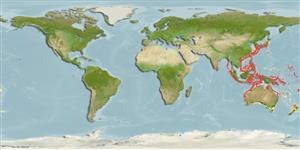>
Anguilliformes (Eels and morays) >
Congridae (Conger and garden eels) > Bathymyrinae
Etymology: Parabathymyrus: Greek, para = the side of + Greek, bathys = deep + Greek,myros, -oy = the male of morey eel (Ref. 45335).
Environment: milieu / climate zone / depth range / distribution range
Ökologie
seewasser demersal; tiefenbereich 100 - 300 m (Ref. 106113). Subtropical
Indo-West Pacific: India, Australia, Japan, China (Hainan), Taiwan and Vietnam.
Size / Gewicht / Alter
Maturity: Lm ? range ? - ? cm
Max length : 47.0 cm TL Männchen/unbestimmt; (Ref. 559)
Kurzbeschreibung
Bestimmungsschlüssel | Morphologie | Morphometrie
Wirbelzahl: 128 - 137. This species is distinguished by the following characters: supraorbital pores 4; head length 5.8-6.8 times in TL; preanal vertebrae 39-46; total vertebrae 128-137; preanal LL pores 36-44; total LL pores 121-132 (Ref. 106113).
Life cycle and mating behavior
Maturities | Fortpflanzung | Spawnings | Egg(s) | Fecundities | Larven
Masuda, H., K. Amaoka, C. Araga, T. Uyeno and T. Yoshino, 1984. The fishes of the Japanese Archipelago. Vol. 1. Tokai University Press, Tokyo, Japan. 437 p. (text). (Ref. 559)
IUCN Rote Liste Status (Ref. 130435)
Bedrohung für Menschen
Harmless
Nutzung durch Menschen
Tools
Zusatzinformationen
Download XML
Internet Quellen
Estimates based on models
Preferred temperature (Ref.
123201): 10.8 - 17, mean 13 °C (based on 50 cells).
Phylogenetic diversity index (Ref.
82804): PD
50 = 0.5156 [Uniqueness, from 0.5 = low to 2.0 = high].
Bayesian length-weight: a=0.00110 (0.00044 - 0.00274), b=3.07 (2.85 - 3.29), in cm total length, based on LWR estimates for this (Sub)family-body shape (Ref.
93245).
Trophic level (Ref.
69278): 4.0 ±0.7 se; based on size and trophs of closest relatives
Widerstandsfähigkeit (Ref.
120179): mittel, Verdopplung der Population dauert 1,4 - 4,4 Jahre. (Preliminary K or Fecundity.).
Fishing Vulnerability (Ref.
59153): Moderate vulnerability (37 of 100).
